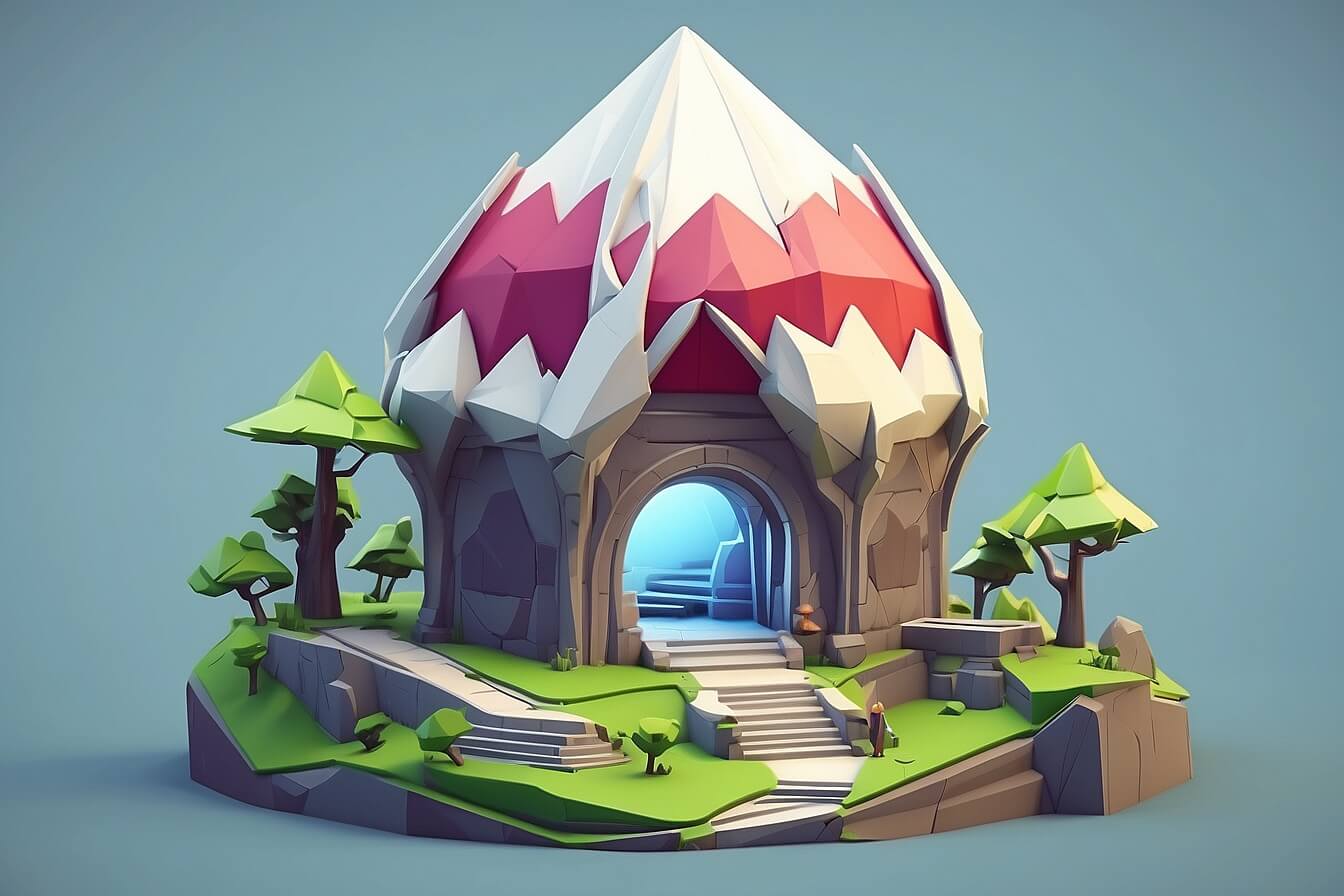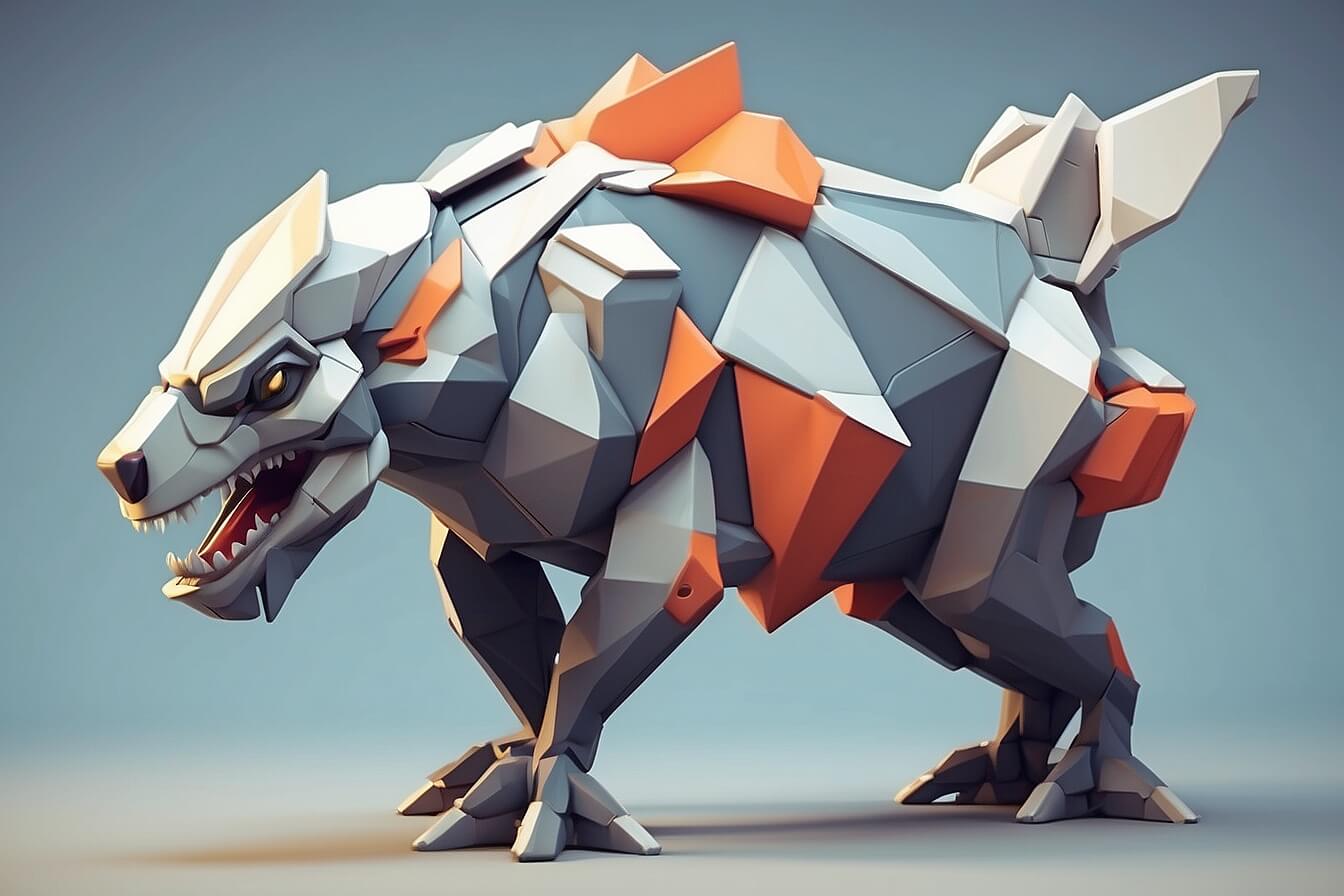What hooks you to a game instantly?
Is it the gameplay? If truth be told, in most games, the thrill of the game mechanics is truly felt after you have played for some time and leveled up slightly. But what keeps the player going till this point is the visuals. With captivating graphics, it is nearly possible to keep players hooked once the actual gameplay excitement starts.
Captivating does not necessarily translate to high-fidelity and hyperrealism. Stylized low-poly game art is gaining traction for its aesthetics and technical simplicity. It is one of the few 3D art styles that end-users and developers love.
Here, we have an in-depth guide on this trendy 3D modeling style, its advantages, use cases, development tips, and challenges to familiarize you with its subtle nuances.
Low-poly game art is a 3D modeling for games and other digital media characterized by its minimalistic style. Polygons are the basic units of 3D graphics, and they come together to form the shapes and surfaces of 3D models. In low-poly art, models are constructed with fewer polygons, which gives them a distinct, faceted appearance rather than smooth and highly detailed surfaces.
Simple, clean lines and geometric shapes mark low-poly art. Due to its minimalistic nature, low-poly art often embraces a more abstract or stylized aesthetic rather than striving for photorealism. These models require less computational power to render in real-time, making them suitable for a wide range of hardware, from high-end gaming PCs to mobile phones. Artists can manipulate the low-poly style to create visually striking and imaginative landscapes, characters, and environments that might look surreal or abstract.
The stylized design is not the only attraction of low poly modeling. To video game developers, this is a feasible choice when resources are limited. It looks good, is less complex, and is more cost-efficient than other game arts. The following are some of the benefits of using low poly 3D models for video game development:
Low-poly models are inherently more efficient for rendering in real-time, requiring less computational power. This efficiency allows games to run smoothly in a broader range of hardware, from high-end gaming PCs to mobile devices and even older systems. It also contributes to faster loading times and can help maintain higher frame rates, which is crucial for a good player experience.
Creating detailed high-poly models and textures can be time-consuming and require significant resources. Low-poly art, by contrast, is quicker to create and animate, which can significantly reduce the time and cost associated with asset production. This is particularly advantageous for indie developers or studios with limited budgets, as it allows them to produce content more efficiently without compromising the game’s visual appeal.
Low-poly art has a unique and recognizable aesthetic that stands out from the more common photorealistic or high-fidelity styles in many modern games. This distinctive style can be leveraged to create memorable visuals and help a game establish its identity in a crowded market. The simplicity and abstract nature of low-poly art can also evoke nostalgia, appealing to fans of early 3D games.
The modeling, texturing, and animating of low-poly assets is generally faster than working with high-poly counterparts. This quicker development cycle can lead to shorter game production times, enabling developers to iterate on designs more rapidly or bring their products to market sooner. Additionally, the simplicity of low-poly models makes them easier to modify or repurpose, further accelerating the development process.
Low-poly art’s simplicity provides a high degree of flexibility in design and implementation. It can be adapted to fit various game genres and artistic visions, from minimalist and abstract to vibrant and whimsical. This flexibility also extends to technical considerations; low-poly models can be easily scaled up with more detail or scaled down to meet performance requirements without losing their essential character.

The first thing to decide for game development is the art style that suits best while being less resource-intensive and quicker to process. Low-poly modeling fits all these criteria perfectly. There are no hard and fast rules on game art style corresponding to the game genre. As a result, the primary determinant becomes the budget, platform, and target audience.
Low-poly game art is highly stylized and versatile at the same time. The art form can be used to create fun and quirky animations like that in Don’t Mess with Texas to the understated somber style of Virginia.
Low-poly 3D models are particularly suited for certain types of games and development processes, such as:
Low-poly game art can significantly optimize performance across various devices, from high-end PCs to mobile platforms. Developers can achieve a smooth, efficient performance by focusing on minimizing complexity without compromising on the visual quality necessary for engaging gameplay.
By design, low-poly art involves using the smallest number of polygons to create assets. This minimalist approach reduces the computational load on the GPU (Graphics Processing Unit), enabling faster rendering of scenes. Keeping assets minimal not only speeds up the rendering process but also decreases memory usage in terms of RAM and storage, leading to quicker load times and a more streamlined game that can run on less powerful hardware.
Implementing Levels of Detail (LODs) is a technique where different model versions are used depending on the camera’s distance from the object. A highly detailed model might be used when the player is close to an object, while a more straightforward, low-poly version is used at greater distances. This approach can drastically reduce the number of polygons that need to be rendered in a scene without noticeably affecting visual quality from the player’s perspective. LODs are particularly effective in open-world games or any game featuring large environments, as they keep performance steady while still providing visual detail where it counts.
Even within the realm of low-poly art, there’s room for optimization. This can include removing unnecessary vertices (points where edges meet), ensuring the geometry is as simple as possible without losing the desired shape, and avoiding overly complex textures that can increase load times. Techniques such as merging objects that are always seen together or baking textures (a process where lighting and shadow details are pre-calculated and included in the texture itself) can also help reduce the required real-time computations.
Performance optimization is not a one-size-fits-all solution, especially when developing games intended for a wide range of hardware. Thorough testing across different devices ensures that the game runs smoothly on various specifications. This process can identify performance bottlenecks and areas where further optimization is needed. It might also involve adjusting LOD settings, texture resolutions, or even the complexity of models for specific devices to maintain a consistent frame rate across all platforms.

While low-poly game art offers numerous advantages, it also presents specific challenges that developers and artists must navigate. These challenges relate to the art style’s inherent simplicity and the technical and creative limitations it imposes.
The most apparent challenge of low-poly art is the inherent need for more detail due to the minimal use of polygons. This limitation can make it difficult to convey complex textures, intricate shapes, or subtle expressions, especially in characters or environments that benefit from high detail levels. Artists must find creative ways to suggest details without modeling them, using color, shading, and lighting effectively to imply complexity.
Animating low-poly models can be particularly challenging. The lack of detail and the simplified structures of these models mean that conveying fluid, realistic movements can be complex. There needs to be more geometry for articulation, which can result in stiff or unnatural animations if handled carefully. Artists must balance the simplicity of the models with the need for smooth and convincing animations, often relying on creative solutions to suggest motion rather than explicitly showing it.
For projects aiming for a realistic aesthetic, low-poly art can be a significant limitation. The stylized nature of low-poly models and environments might not suit games or applications that require photorealistic visuals to achieve their desired impact. This challenge extends to creating realistic lighting, shadows, and textures, which are all more challenging to implement within the constraints of low-poly art convincingly.
Creating low poly 3D models is an art form that requires a balance between minimalistic design and conveying enough detail to capture the subject’s essence. Here are some tips to help you create effective low poly 3D models, leveraging simplicity while creating visually engaging and recognizable forms.
The aesthetic limitations of low poly modeling are somewhat overcome by combining the following advanced techniques of 3D game modeling services:
This method allows artists to add color directly to vertices (corners) of polygons in a 3D model. Since low-poly models have fewer faces, traditional texturing methods sometimes result in a loss of detail. Vertex painting can overcome this by allowing for gradients and subtle variations across the model’s surface without the necessity of complex textures. This technique can add depth and richness to a model, enhancing its visual appeal while keeping the polygon count low.
Procedural 3D modeling refers to creating 3D models and textures through algorithms and rules rather than by hand. This approach can be particularly beneficial for low-poly art by automating the creation of complex forms and patterns with minimal manual input. Procedural techniques can efficiently generate landscapes, vegetation, cities, and other intricate models. These models can be highly customizable and easily tweaked to create variations, making procedural modeling a powerful tool for generating diverse game content.
The 3D models appear as though they were hand-drawn, emulating the style of 2D illustrations and animations in Cel Shading. This technique is characterized by its distinct, flat colors and bold outlines. In the context of low-poly art, cel shading can add a vibrant, cartoon-like aesthetic that complements the geometric simplicity of the models. It’s particularly effective in giving games a unique visual style that stands out, blending the minimalistic nature of low-poly models with the expressive quality of hand-drawn art.
UV unwrapping is projecting a 3D model’s surface onto a 2D plane to create a texture map. This map dictates how a 2D texture fits onto the 3D model. In low-poly art, UV unwrapping is crucial for adding details to simple models without increasing the polygon count. By carefully unwrapping a model and painting or generating detailed textures, artists can imply complexity and detail on a flat surface. This technique is essential for adding visual interest to low-poly models, allowing textures to convey information that the geometry does not.
The art of 3D modeling for games is varied and complex. While there are different types of 3D art forms, low poly styles are gaining popularity by the day for their aesthetics and simplicity. Understanding the concept of low-poly modeling lets developers make the most of this art form for games.
At Juego Studios, we offer 3D game modeling services using state-of-the-art tools. Our experienced developers are proficient with various 3D art forms, including low poly modeling. Witness our team design any game featuring this art form and make your dream project successful.